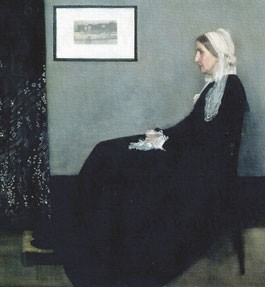SHOCK OF THE NEW: Whistler’s maternal portrait startled viewers of the time.
By Richard von Busack
At the press preview, San Francisco mayor Gavin Newsom gave the best justification for the first of two shows at the de Young Museum, “The Birth of Impressionism: Masterpieces of the Musée d’Orsay”: “It’s better than storing them in a basement gathering dust.” Good ol’ Gavin.
This expensive ($20–$25) show is the first of two helpings from the Orsay. The Paris museum is temporarily closed for refurbishing for its 25th anniversary.
Those expecting sailboats and flowers will be in for a surprise. Like two cinematic blockbusters this year, Robin Hood and Alice in Wonderland, this show turns out to be a prequel. It’s a primer for how the revolution in painting (and seeing) took place.
I suppose the show argues that if there is such a thing as post-impressionism, there should be such a thing as pre-impressionism. But those looking for a clear narrative pathway to the future are sure to be confused.
Everything outside official salon painting was a big everything, a group of artists in common cause, from the roots of ashcan (in Falguière’s 1875 The Wrestlers) to social realism (Jules Breton’s 1877 The Harvester, a portrait of a colossal peasant brandishing a sheaf of wheat big enough to knock down a horse). It’s a group of winding roads we have, leading to the lonely, stony hills of Cézanne and the moody pastures of Pissarro. And what’s Whistler’s Mother doing here? (Three people I met asked that question.)
Arrangement in Gray and Black, No. 1: Portrait of the Artist’s Mother (1871) is misunderstood as a lampoon of the subject. Seen in flank view, she’s a very old woman, the epitome of lace-capped homeliness. It’s a much larger painting than you’d expect, and its size emphasizes the radical approach: a flatness assumed from Japanese art, with planes of color stark to the point of monochromatic. It was a drastic, divisive painting, exposed to mockery in its day. “Poor lady, posed like a sack of coal,” sighed one cartoonist.
In fact, the Whistler painting is a breakthrough, an icon-blaster in a time favoring allegories and classical subjects. I liked—maybe better than anything in the show—another essentially non-impressionist, Gustave Moreau’s 1865 rejoinder to standard classicism, Jason et Médée. It’s a troubling painting of the pair entwined like Chagal lovers: the murderous wife Medea swoons at the teenage warrior who is as golden as the fleece he stole.
The effect of railroad travel on art is a subtext of this show. Just as we started to get more abstract paintings of flat fields and geographical shapes after air travel became deregulated and cheap, the rise of French rail prepared viewers for the shimmer of light: paintings as if seen through a window, traveling fast. Monet’s 1877 picture here of the Gare Saint-Lazare crowned in steam suggests this love of rail. Vacationers now had cheap access to the cloudy French beaches to become bathers and, of course, sailors, as we were to see in painting after painting.
The popularity of photography caused a rise in the informal image: Frederic Bazille’s 1867 portrait of Renoir crouched with his heels on a chair; Degas’ study of a lady getting a pedicure; Gustave Caillebotte’s somber 1876 image of workers scraping a floor.
Impressionism exalted the informal, the earthy. Monet’s delightful 1876 painting of a crowd of sophisticated looking white turkeys, glowing like angels as they strut up a hill, leaves us firmly in the hands of the movement to be—and ready for September’s follow-up.
‘The Birth of Impressionism’ runs at the de Young through Sept. 6. Also, ‘I Keep Fooling Around,’ prints by Marin master William T. Wiley, shows in the main museum through July 4. $11. 50 Hagiwara Tea Garden Drive, San Francisco. 415.750.3600.











